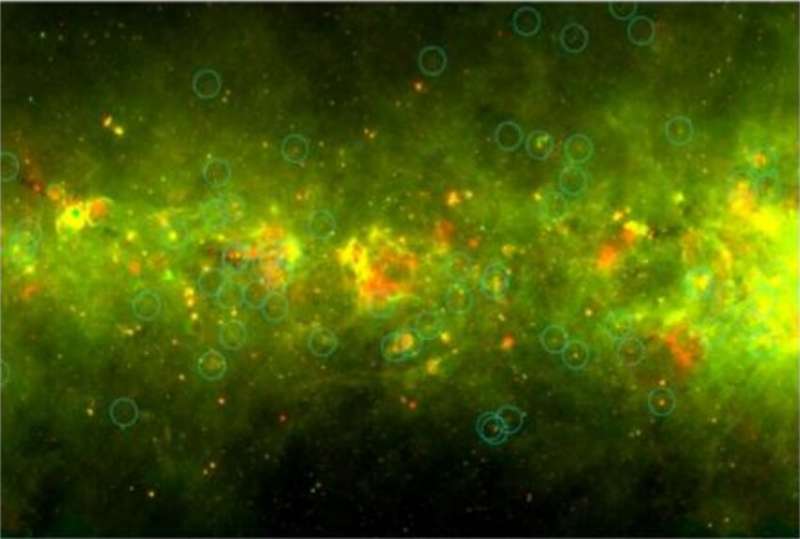Why do massive (and not-so-massive) stars form?

The Milky Way Project: Probing Star Formation with a New Yellowball Catalog presents a study of 518 infant star-forming regions known as "Yellowballs," drawn from a catalog made possible by the efforts of citizen scientists. The Milky Way Project is one of roughly 100 research initiatives in Zooniverse, the world's largest online platform for citizen science. During 2016-2017, citizen scientists identified more than 6,000 Yellowballs (YBs), which were named for their appearance in Spitzer Space Telescope images. A major result of the new study is that YBs provide snapshots in time of nascent star-forming regions spanning an enormous range of mass and luminosity.
When the Milky Way Project was first launched, it didn't include searching for YBs—they were added as principal targets only after they were discovered serendipitously by citizen scientists. The color and appearance of YBs come from the way the infrared wavelengths are represented in the Spitzer images and the compact sizes of these objects. The infrared images use different colors to represent wavelengths that are invisible to the human eye. Complex organic molecules known as Polycyclic Aromatic Hydrocarbons (or PAHs) show up as green in the images, and very small dust particles as red—where the two overlap completely, you get yellow. YBs are larger than our solar system, but most are considerably smaller than the typical distance between stars, and yet some of them may eventually produce thousands of stars.
The new catalog contains the positions and sizes of YBs across a large swath of the Milky Way, including regions toward the inner and outer parts of our galaxy, where stars form under different conditions. The researchers chose a sample of YBs located in a well-studied region of the Milky Way in order to compare the sample with other cataloged indicators of star formation. Their pilot study enabled them to compute distances to the YBs, determine their physical properties, and ascertain that many of these young star-forming regions were missed by other large surveys.
"YBs are helping us investigate a critical but hitherto elusive question: how do the properties of stars depend upon the properties of the cold, dusty clouds in which stars form?"' said Dr. Grace Wolf-Chase, Adler Planetarium astronomer and one of the study's authors. The reason this question has been elusive is because, once formed, young stars produce winds and radiation that quickly destroy their birth environments.
The fact that most stars form in close company with many other stars complicates the picture even further. "The trick is to catch these newborn star clusters before they 'clear house,'" said co-author Dr. Charles Kerton, associate professor of astronomy at Iowa State University.
Some YBs are producing very massive stars—the kind of stars that eventually explode as supernovae and enrich their surroundings with heavy elements—while others aren't. Understanding how the environments that produce massive stars differ from those that don't is a key unresolved and important question, since massive stars are critical to the production and distribution of heavy elements. In fact, our solar system is thought to have formed in the company of massive stars, so YBs may tell us a lot about the conditions that led to our own origins.
Zooniverse is a non-profit collaboration led by the Adler Planetarium and University of Oxford. It has engaged over 1.7 million citizen scientists around the world, and has resulted in more than 200 research publications. The authors are determined to make full use of the YB catalog provided by the citizen scientists working on the Milky Way Project, and the next steps are clear. Co-author Kathryn Devine, associate professor of physics at the College of Idaho, said, "We have been working with several talented undergraduate students, who are helping us automate and apply our analysis procedures to the entire YB catalog, so we can explore how stars develop in different environments across our galaxy."
More information: Previous study results: C. R. Kerton et al. THE MILKY WAY PROJECT: WHAT ARE YELLOWBALLS?, The Astrophysical Journal (2015). DOI: 10.1088/0004-637X/799/2/153
The Milky Way Project can be found at www.zooniverse.org/collections … er/milky-way-project
Journal information: Astrophysical Journal
Provided by Adler Planetarium





















